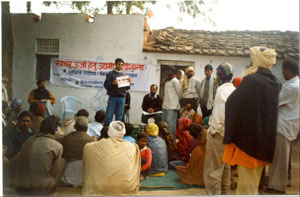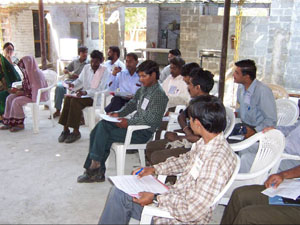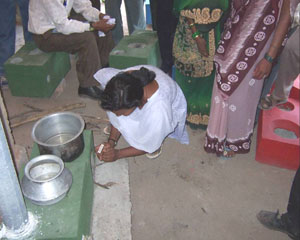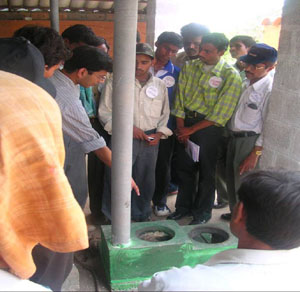| Techno-social Integration for Clean Energy Solutions Saurabh Rastogi The present energy usage pattern of the people of Bundelkhand region of the  central India reflects their poor quality of life. The energy usage pattern of the people includes the use of conventional cook stoves (mostly C-shaped, fixed clay structures with single outlets) generating lots of smoke in and around the cooking space, and kerosene lit lamps emitting carbon monoxide, causing serious danger to the health of family members, especially women. central India reflects their poor quality of life. The energy usage pattern of the people includes the use of conventional cook stoves (mostly C-shaped, fixed clay structures with single outlets) generating lots of smoke in and around the cooking space, and kerosene lit lamps emitting carbon monoxide, causing serious danger to the health of family members, especially women. Looking at peopleís aspiration and desire for clean and affordable energy solutions, a process has been initiated to promote and commercialize clean energy products and services, with due support  from Shell Foundation. Accordingly, a project titled "Energy services in the rural households and livelihood enterprises in the Bundelkhand region of India", supported by Shell Foundation, is focused on designing a model that services the energy needs of rural households and communities. It will create an enterprise support system and strengthen livelihoods at the village as well as block level. from Shell Foundation. Accordingly, a project titled "Energy services in the rural households and livelihood enterprises in the Bundelkhand region of India", supported by Shell Foundation, is focused on designing a model that services the energy needs of rural households and communities. It will create an enterprise support system and strengthen livelihoods at the village as well as block level. Considering the food habits of the local people (comprising mostly `Roti' and vegetables) of the region, different models of cook stoves with a chimney (made up of cement concrete) with different price tags have been developed by Development Alternatives. The marketing of the stove is being done under the brand name TARA Shakti. Methodology | ∑ | Awareness campaign and information sharing have been carried out to create awareness regarding the ill effects of unreliable, inefficient and polluting energy usage pattern and thereby bringing in behavioural changes among the rural communities through social mobilization and solutions have also been provided for the same. This has helped them to understand new ideas and value their awareness well enough to bring abount a social change. Therefore, the involvement of community based institutions such as SHGs, federations, focused group discussions, personal interviews of the influential people in the villages, video films depecting drudgery havse further helped to create sensitivity to this social cause. The promotional material such as posters, leaflets, wall paintings, wall slogans etc. have been placed in important places of the village, weekly haats, health centres etc. for mass replication. Theme camps/street plays have been organised in the villages by hiring local artists. | | ∑ | Demo cum User trial have been organised to enable the people to have the glimpse of the product and the interested people have been selected to test it further by cooking their meals and get convinced and satisfied. The field-testing of the product has motivated the people to take a positive action. This is quite evident from the fact that as of now, 425 TARA Shakti cook stoves have been disseminated in the rural areas of Bundelkhand. | | ∑ | Social Marketing workshop on clean indoor air was organised by United States Environment Protection Agency in collaboration with Development Alternatives in Jhansi, where officials from Health Dept., Forest Dept., Bank Officials and rural communities participated . The objective of the workshop was "How to develop an effective social marketing campaign for maximum impact to reduce Indoor air pollution by adopting clean energy products and services". The thrust was on communicating the ill effects of indoor air pollution on the health of women and children in particular, by developing effective messages to initiate positive behavioural changes among the target audience. | | ∑ | Comparative study and field-testing has been done in households who were dissatisfied with TARA Shakti stove. A comparative study was conducted (keeping some parameters constant) in the dissatisfied userís house, and the data has been recorded and shared with the community of that particular village. This study helped them to get convinced and motivated others to buy one for their house too. | | Userís perception and feedback | | ∑ | A Userís Perception Team, consisting of three female members had been formed to gather feedback from all the users in a prescribed format. The team visited all the users of the TARA Shakti Stove to find out the reasons for their satisfaction and dissatisfaction. Accordingly, certain modifications have been done in TARA Shakti Stove to make it more user friendly. | | ∑ | Appointment of Installation team at the village level: Initially, interested unemployed youths from each cluster were identified and were appointed as TARA Shakti stove installers and were paid Rs. 20 per stove as installation charges. A workshop to this effect was organised in which they have been given an orientation and training regarding TARA Shakti stove installation. As of now, there are installers in most of the villages of the pre-defined clusters. Some of them were given on-the-job training for the same. | Appointment of Marketing Associates (MAs) Under this process, 12 interested unemployed youths from all the defined clusters were identified and appointed as Marketing  associates and a workshop to this effect was organised in TARAgram. These marketing associates will be paid incentives/commission on different sales slab on a monthly basis. Initially, project team, used to assist them in creating awareness and hence build up their marketing skills. Apart from this, a fortnightly meeting of all MAs is regularly being held to review their progress and listen to their problems (if any) and find solutions for the same. associates and a workshop to this effect was organised in TARAgram. These marketing associates will be paid incentives/commission on different sales slab on a monthly basis. Initially, project team, used to assist them in creating awareness and hence build up their marketing skills. Apart from this, a fortnightly meeting of all MAs is regularly being held to review their progress and listen to their problems (if any) and find solutions for the same. Mobile campaign To expedite the process of Shakti stove dissemination, mobile campaigns were organised in all the new villages along with newly appointed MAs. The objective behind this was to build the marketing skills of the MAs and parallely c reate awareness and mobilize the community in new villages regarding clean energy products and services. This resulted into rapid dissemination of Shakti stoves, as 200 stoves were installed between 1st May to 30th June 2004 as compared to 177 installed between November 2003 to April 2004. reate awareness and mobilize the community in new villages regarding clean energy products and services. This resulted into rapid dissemination of Shakti stoves, as 200 stoves were installed between 1st May to 30th June 2004 as compared to 177 installed between November 2003 to April 2004. Incentive Disbursement Incentives were disbursed to MAs for the month of June 2004.  The highest incentive of Rs. 960 was paid to Mr. Vinod Yadav of Kuwarpura village of Niwari cluster, who sold 16 stoves in the month of June 2004 and the lowest (Rs. 528) for 11 stoves being paid to Srimati Guddi Devi of Thona cluster, Niwari. The disbursement of incentives created a lot of enthusiasm among the MAs as is clearly evident from the fact that Mr. Vinod Yadav got another order of 15 stoves from one of his target villages. The highest incentive of Rs. 960 was paid to Mr. Vinod Yadav of Kuwarpura village of Niwari cluster, who sold 16 stoves in the month of June 2004 and the lowest (Rs. 528) for 11 stoves being paid to Srimati Guddi Devi of Thona cluster, Niwari. The disbursement of incentives created a lot of enthusiasm among the MAs as is clearly evident from the fact that Mr. Vinod Yadav got another order of 15 stoves from one of his target villages. Micro Enterprise Development In compliance with the project objectives, efforts have been made to identify potential entrepreneurs for production and marketing of TARA Shakti Stove. As a result of this, two existing MCR (Micro Concrete Roofing tiles) entrepreneurs and a group of unemployed youths from a target village have shown keen interest in manufacturing and dissemination of TARA Shakti stove. entrepreneurs for production and marketing of TARA Shakti Stove. As a result of this, two existing MCR (Micro Concrete Roofing tiles) entrepreneurs and a group of unemployed youths from a target village have shown keen interest in manufacturing and dissemination of TARA Shakti stove. Outcome The outcome of above activities is that people are now more aware and have started accepting that now there are better alternatives to their traditional stove. This is clearly evident from the fact that as of now, nearly 425 TARA Shakti stoves have been installed and more and more people are coming forward to be associated with the clean energy programme. q
Back to Contents
|
 central India reflects their poor quality of life. The energy usage pattern of the people includes the use of conventional cook stoves (mostly C-shaped, fixed clay structures with single outlets) generating lots of smoke in and around the cooking space, and kerosene lit lamps emitting carbon monoxide, causing serious danger to the health of family members, especially women.
central India reflects their poor quality of life. The energy usage pattern of the people includes the use of conventional cook stoves (mostly C-shaped, fixed clay structures with single outlets) generating lots of smoke in and around the cooking space, and kerosene lit lamps emitting carbon monoxide, causing serious danger to the health of family members, especially women. from Shell Foundation. Accordingly, a project titled "Energy services in the rural households and livelihood enterprises in the Bundelkhand region of India", supported by Shell Foundation, is focused on designing a model that services the energy needs of rural households and communities. It will create an enterprise support system and strengthen livelihoods at the village as well as block level.
from Shell Foundation. Accordingly, a project titled "Energy services in the rural households and livelihood enterprises in the Bundelkhand region of India", supported by Shell Foundation, is focused on designing a model that services the energy needs of rural households and communities. It will create an enterprise support system and strengthen livelihoods at the village as well as block level.  associates and a workshop to this effect was organised in TARAgram. These marketing associates will be paid incentives/commission on different sales slab on a monthly basis. Initially, project team, used to assist them in creating awareness and hence build up their marketing skills. Apart from this, a fortnightly meeting of all MAs is regularly being held to review their progress and listen to their problems (if any) and find solutions for the same.
associates and a workshop to this effect was organised in TARAgram. These marketing associates will be paid incentives/commission on different sales slab on a monthly basis. Initially, project team, used to assist them in creating awareness and hence build up their marketing skills. Apart from this, a fortnightly meeting of all MAs is regularly being held to review their progress and listen to their problems (if any) and find solutions for the same. reate awareness and mobilize the community in new villages regarding clean energy products and services. This resulted into rapid dissemination of Shakti stoves, as 200 stoves were installed between 1st May to 30th June 2004 as compared to 177 installed between November 2003 to April 2004.
reate awareness and mobilize the community in new villages regarding clean energy products and services. This resulted into rapid dissemination of Shakti stoves, as 200 stoves were installed between 1st May to 30th June 2004 as compared to 177 installed between November 2003 to April 2004. The highest incentive of Rs. 960 was paid to Mr. Vinod Yadav of Kuwarpura village of Niwari cluster, who sold 16 stoves in the month of June 2004 and the lowest (Rs. 528) for 11 stoves being paid to Srimati Guddi Devi of Thona cluster, Niwari. The disbursement of incentives created a lot of enthusiasm among the MAs as is clearly evident from the fact that Mr. Vinod Yadav got another order of 15 stoves from one of his target villages.
The highest incentive of Rs. 960 was paid to Mr. Vinod Yadav of Kuwarpura village of Niwari cluster, who sold 16 stoves in the month of June 2004 and the lowest (Rs. 528) for 11 stoves being paid to Srimati Guddi Devi of Thona cluster, Niwari. The disbursement of incentives created a lot of enthusiasm among the MAs as is clearly evident from the fact that Mr. Vinod Yadav got another order of 15 stoves from one of his target villages.  entrepreneurs for production and marketing of TARA Shakti Stove. As a result of this, two existing MCR (Micro Concrete Roofing tiles) entrepreneurs and a group of unemployed youths from a target village have shown keen interest in manufacturing and dissemination of TARA Shakti stove.
entrepreneurs for production and marketing of TARA Shakti Stove. As a result of this, two existing MCR (Micro Concrete Roofing tiles) entrepreneurs and a group of unemployed youths from a target village have shown keen interest in manufacturing and dissemination of TARA Shakti stove.